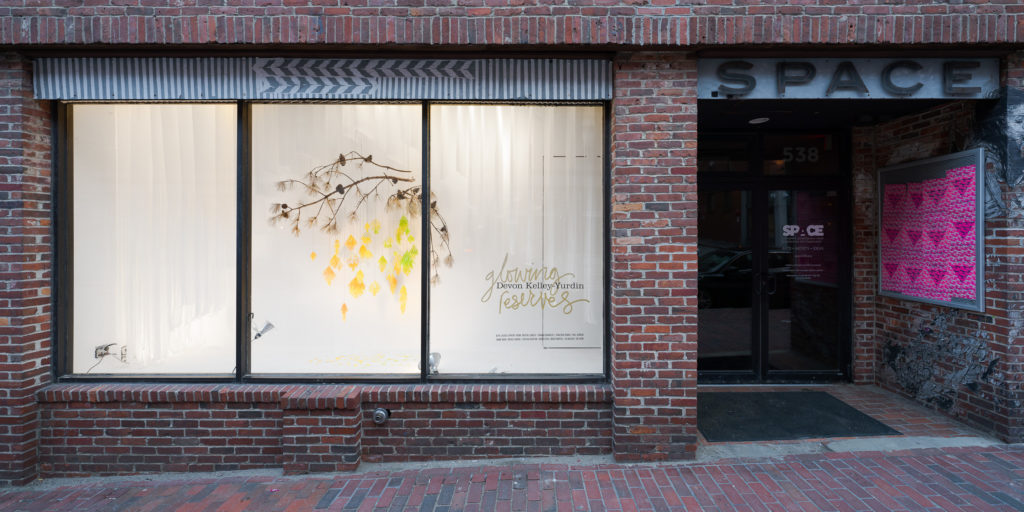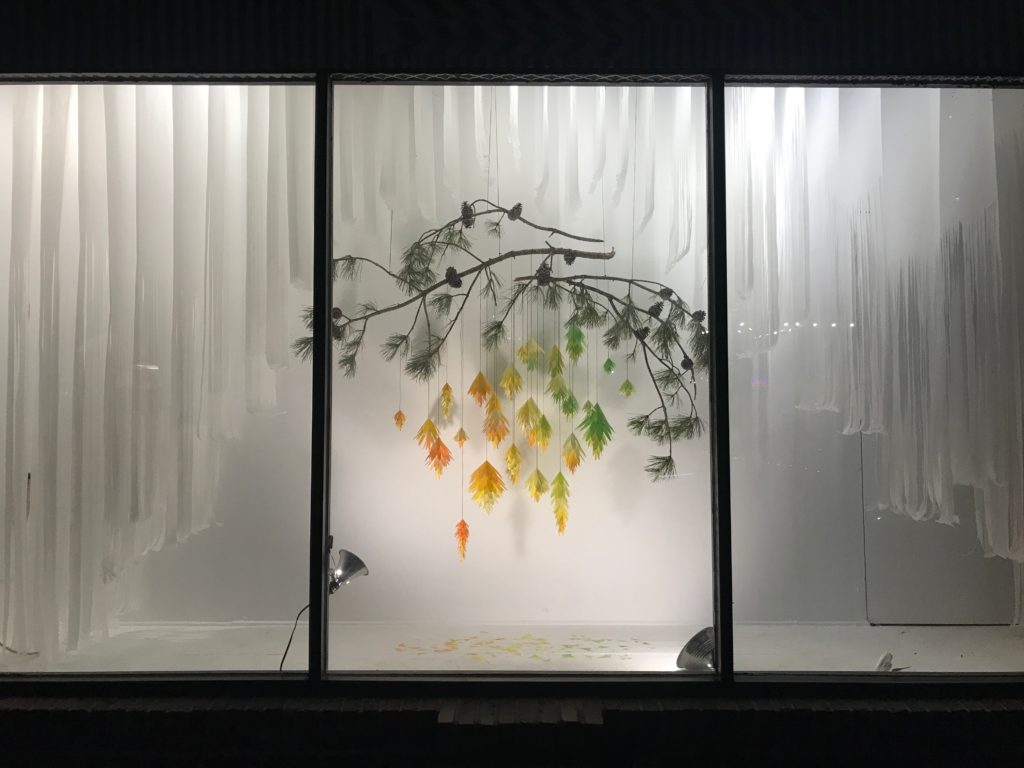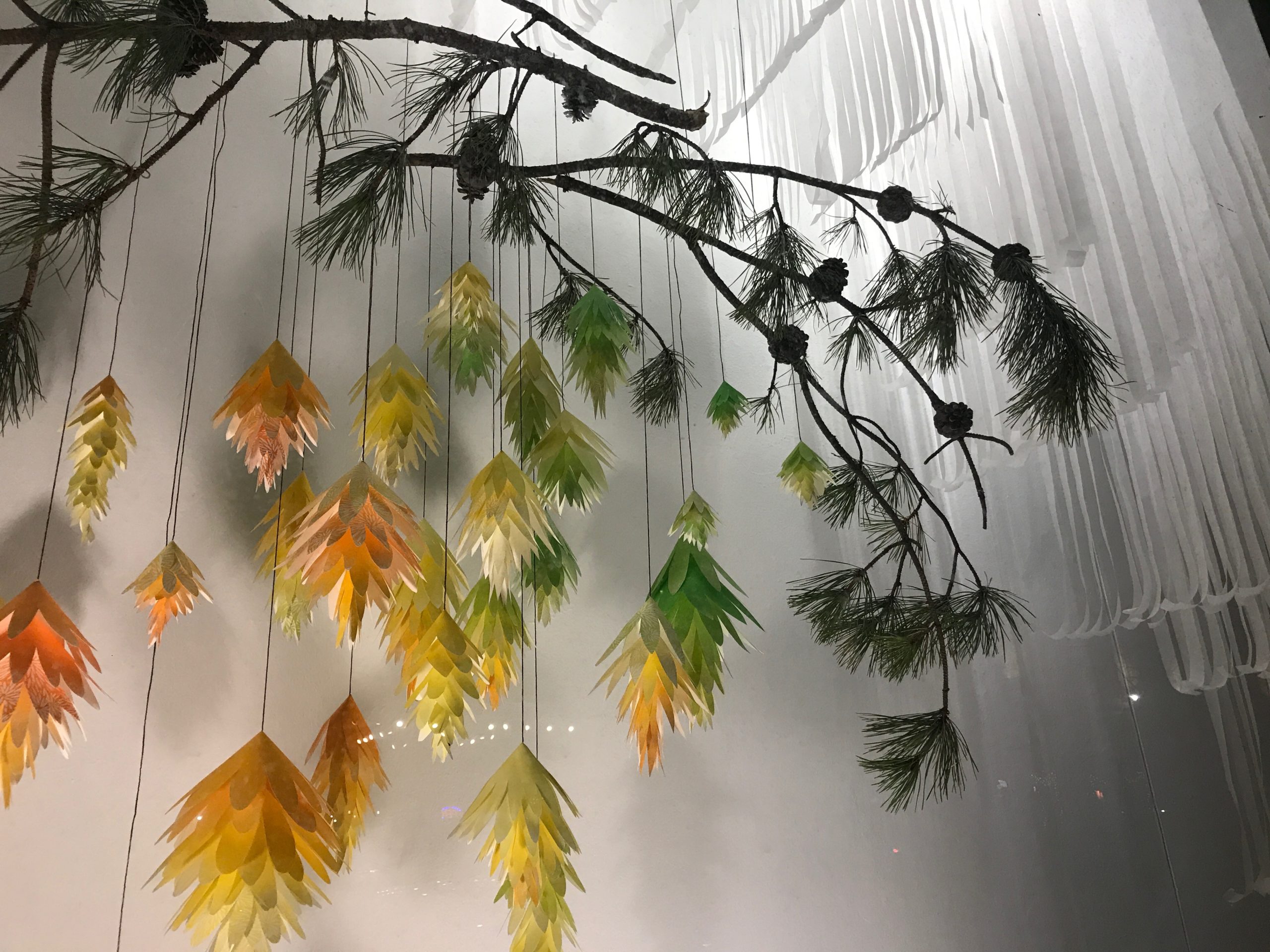I recently zoomed with Devon Kelley-Yurdin to reflect about their installation Glowing Reserves shortly before it closes. We talked about the core intention of the work, beauty as an accessibility strategy, how to reimagine collaborative, community-based projects on digital platforms, and tech shabbat. Kelley-Yurdin has recently held residencies at Hewnoaks Artist Colony, Vermont Studio Center, and Monson Arts and will be an artist in residence this summer at the Ellis-Beauregard Foundation. They were recently named one of 10 Emerging New England Artists by Art New England.

Your installation Glowing Reserves in SPACE’s window gallery opened March 1st. In your words at the time, the project was guided by the question, “What will people need in Maine in March?” and hoped to catalyze levity, connection, and emotional respite in winter.
Obviously, no one was prepared for the pandemic. Can you reflect on your initial intentions for the piece? How has that evolved now shortly before the show will close?
What will people in Maine need in March……[long sigh, then laughter]
Late winter/early spring is hard in Maine no matter how you slice it… but this slice was something else. I think the project ended up taking its own shape in a way I couldn’t have anticipated but was really grateful for. The purpose of the piece was always – what will people need at this part of late winter that is notoriously challenging. Guided by that question, I was thinking about creating a world that felt warm and transportive. Thinking about how the piece itself could be an offering during that hard time of year.
The project was conceived prior to coming into some pretty big physical health challenges in January/February, which shifted the whole thing. I needed a lot of help. Since it required a team of folks to complete, it turned into a collective offering. An offering of care to the people of Portland, but also an offering of care to me personally in a moment of real challenge. It became a way for all of us to come together to make this thing. And all the folks who showed up really wanted to be there, which is always super important to me. If it doesn’t feel fun or joyful or available to you to come help, if it only feels like an obligation or something, then it’s absolutely right for you not to be there. That way the folks who were there were all in, and it became this act of collective care. I was really proud of what we made, and was so touched by the level of investment that some folks showed up with — I felt so held and so grateful.
Then I finished installing and literally the next day left for a residency at Monson Arts on March 1. I didn’t have a chance to really process what we had done together. It wasn’t long into the residency once the coronavirus was starting to become more of a reality here in the US, and the energy really shifted there. How to get home, if we should leave early, were we stuck there. So many questions and unknowns. In the midst of that I was getting these messages from people back in Portland. Heartwarming things, about the installation providing moments of pause, breath, or beauty in the midst of all this. It was just exactly the point, even though we could have never anticipated the scale of the thing we’d need respite from.
It is strange to me that it is still up, and it almost has this feeling to me of being abandoned there. The live branches have totally changed color, the battery on the fan died. Downtown feels so different. I guess time being an unexpected element of this installation, in this moment when time feels so bizarre, seems weirdly appropriate. There is something to me that is both poetic and kind of sad about this offering still being in there doing it’s thing. It doesn’t really even feel like it’s mine anymore.

It is still beautiful. Undeniably. What is your relationship to the idea of beauty?
I don’t think that art has to be beautiful, but I do just really enjoy the process of creating things that feel beautiful to me. I like trying to dazzle myself in the studio, surprising and challenging myself, making things that look and feel… delicious. And, honestly, I do like to put on a bit of a show. But maybe more importantly, making “beautiful” things is a part of how I think about making accessible work. Obviously everyone’s taste is different, but for me it feels huge to make something that someone who doesn’t think they know anything about art can look at and simply think, “I like that.” I think that’s really powerful. Of course I hope I’m making things that are conceptually evocative, but I don’t want folks to necessarily have to know those concepts in order to have their own experience of pleasure and joy, or whatever else, while looking at it.
You identify in your artist statement as an “instigator of collective experience” and many of your creative projects in the past have been designed for community engagement. How are you processing this moment of collective isolation and the loss of physically gathering?
There’s a lot about it that just really sucks from a connection and creative standpoint. And also, as someone who chronically over-schedules, I am enjoying that FOMO is just like… not a thing right now.
I get a huge creative charge from quality interaction with other people, like I can get kind of high from it. And finding ways to engage folks collectively in vulnerable and meaningful ways is how I am as both a facilitator and as just a person. But there is definitely also a huge part of my practice that is just me and my own brain — there’s a lot happening in there. Being in relationship with myself and with nature is a huge part of my practice, so I am trying to just sink into that space for the time being. Between being sick this winter, the residency, and then lockdown, I think I’ve probably spent more time alone in 2020 than any other time in my life. But yeah, I’m so antsy for connection and there is a big part of my creative self that hasn’t figured out how to be activated right now.
In the beginning of all this I was thinking about what really connective virtual space even looks like. I’d been doing some brainstorming about hosting a virtual Going For It, and I am still thinking about that, but I’m especially puzzled about it because I feel like I’ve developed a total aversion to video conferencing. Zoom, while a useful tool, also creates so much space for only being halfway present. I am interested in what it looks like to create an invitation for something that is asking people to show up with similar emotional investment as they would if they were physically there, or to engage in some sort of tactical way. I’m excited to be participating in A Possible Practice, which is a yearly creative cycle created by A Clearing, in which they invite artists/people of many disciplines to engage with the same chosen poem. This year it’s, “The World Keeps Ending, and the World Goes On” by Franny Choi. I’m going to be hosting some sort of virtual gathering series around reading and re-reading the poem for a few consecutive months coming up, although the details haven’t been solidified. And I’ve also been engaged in similar conversations with my co-fellows and collaborators of the In Kinship Archives and Performance Fellowship. We were supposed to have some sort of performance-based gathering in June, but are talking about other ways that that could look both in form and timeline. So, definitely thinking a lot about other ways to gather and/or experience things, but also definitely feeling pretty sad and confused about how different connecting feels right now.
I do have a few little projects that I have been working on — at the beginning of the stay-at-home time I made a coloring book and shared it online for download. I have been ridiculously attentive to my garden and my DIY haircut. I’ve rearranged many shelves and altars. My houseplants have never been happier. I don’t have children, clearly. I’m about to be in residency at the Ellis-Beaurigard Foundation in Rockland for a couple months this summer, and I feel lucky and grateful to be heading back into a place of intentional creativity, but have no idea how that will look… I don’t even really know what work I’m making right now. I think we’re culturally conditioned to think of creativity as indulgent, and holding the counter-narrative can be hard work sometimes even when you know it’s true. But I do really believe in this moment that my work as a creative person is one of the best ways I can be of service and be useful, while trying to not get stuck prioritizing usefulness as it applies to productivity under capitalism. Creativity, and also reparations/redistribution and showing up for my people.
It’s been pretty easy to get lost in the grief of this whole pandemic. I’ve spent a lot of time feeling pretty overwhelmed and also so rageful about how all this has gone down and who is being most negatively affected by it. It’s easy to pin it on our incompetent federal administration, but the inequity is here too. In Maine alone, the racial disparities in the data of Covid cases is appalling. It’s not surprising, given the structural violence of white supremacy… but fuck. My experience of isolation right now is one of extreme privilege.
You also shared recently that you have begun “tech shabbat” sundown Friday until sundown Saturday and that it has been a really positive experience for you. Has that been a good countermeasure to this moment where technology, and social interaction and work are all fused together?
Yeah, I’m on week 7 or 8 now and it’s become a true favorite thing. Which I always think is funny, because I could turn my phone off literally any other time. But I sincerely look forward to it all week.
There’s something that’s been so important about allowing my thoughts to just be my own. That’s the thing — with the reduction of input, I feel like there is a higher level of synthesis. I really slow down, and end up much more attentive to the needs of the moment. I also end up doing things that I have been meaning to do but never prioritize. Like I had this stack for over a year of plates that were chipped and had pieces to be repaired, and during one Shabbat I just sat there in silence gluing these plates back together. It was amazing.
I almost feel less lonely when it’s just me without my phone than with it. I am not feeling like half-way connected with others, I am just feeling present. By Saturday evening when I turn my phone back on, my mood has usually completely shifted and I feel refueled.
Also, on those days, I sometimes go on walks in my neighborhood and knock on friends’ doors for distance stoop hellos. Everyone is home. It’s the best! I am trying to bring back the “stop-by.”
If you were to pick one artist (expansively understood), from any point in history, to be isolated with during Covid-19, who would it be? Imagine the ideal creative studio situation for you and one other person, who would you want that person to be?
It is hard to think about because I literally only want to see my friends. [laughs]
If I am thinking in terms of art history, Hilma af Klint. Why wouldn’t you just want to be doing quarantine seances with Hilma?
But actually, for the past couple years I had been co-organizing this experimental movement class with some friends and collaborators. It’s called SPELL (South Portland Experimental Language League turned interStellar Portland Experimental Language League). The people who I collaborate with are all folks who are interested in throwing ideas out there and using collective process as a way to practice and build decentralized leadership and emergent ideas. It is not about expertise in any creative practice. I don’t know if some of the folks involved would even use the word artist for themselves, even though I would. To me, they would be the ideal isolation partners — people who are thinking outside of the art world, who are involved in direct service and social justice and organizing, people who are interested in just trying things. I’ve found that space to be incredibly healing. It’s silly and connective and creative, but it is also directly building muscles that are so desperately needed in our work against systemic violence and inequity. When we can use a creative platform to exercise things that we need to be doing out in the world, that is the sweet spot for me. That’s from where and with who I want to be building.
All that being said, I’d also be super down to be in quarantine with my In Kinship collaborators.
Leave it to me to be like, one person? I actually want six people.



